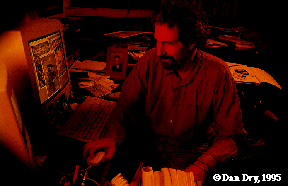
 The University of Chicago Magazine October 1995
The University of Chicago Magazine October 1995


Think onions, not books. Robert Winter, quick with a memorable explanation, offers this homely metaphor for his interactive works. Unlike books, he says, his software doesn't steer every user along the same path. Slice into one of his programs (don't expect tears) and start almost anywhere-depending on whether you fancy cultural history, music theory, or biography. "At the outer onion layer," he says, you'll find accessible material that "often looks to people who don't look any further like sell-out popularization. But what I do is invite people to find out more, and go to the center of the earth if they so desire. Which is really the same choice they get everywhere else in life."
Everywhere except "traditional education," he says, "where you're told, 'The material for this course is such-and-such…and you'll be tested on it at the end of the quarter.' That's the old analog world."
The new interactive world's mix of flexibility and easy entry means that Winter's CD-ROMs, unlike many books, can simultaneously target multiple audiences: laypeople, music professionals, and children. That ability may outmode prejudices about what counts as "serious" research. "In the digital age," says Winter, "the distinction between scholarship and popularizing is really irrelevant."
Are his colleagues as enthusiastic? Already, "his works are used quite often" in college classes, says Northwestern music professor Peter Webster, who features Winter's Beethoven and Stravinsky CD-ROMs as "exemplars" of their genre in a course on music and technology. Still, Webster adds, "There is a debate in the field whether it's more appropriate for music majors or non-music majors."
For Winter, the question facing multimedia isn't one of potential-it's living up to it. Despite the frequent raves issued by "hardware-oriented" computer journalists, most CD-ROMs, he believes, "aren't worth the investment required to play them."
"We're all struggling to define what the conventions will be," he explains. "The reason most titles fall short is that we're comfortable with single paradigms," such as modeling multimedia after books, slide shows, or theater. A case in point: To create his four works published by the Voyager Company, Winter used Apple's HyperCard program-"an out-and-out book metaphor," unable, for instance, to include animation. As a result, he concedes, those programs are "too bookish."
There's been progress, of course. Since his first "CD Companion," the 1988 guide to Beethoven's Ninth Symphony, he's added better audio and a musical score. But the big leap comes in November, when his new company, Calliope Media, issues the first CD-ROM to use a new, "multi-paradigm" programming language (Calliope's second release, it follows a multimedia version of Tennessee Rice Dixon's artist's book, Scrutiny in the Great Round). Winter's upcoming CD-ROM will exploit a host of new features to illuminate the music of ragtime. More features, more paths through the onion: However one travels, Winter wants to make the trip as enlightening as possible. A computer and CD-ROM player, after all, cost "at least $1,500," he points out. "I ought to get something pretty good for that-awfully good."
Continue reading "Digital Vision"
Return to opening of "Digital Vision"
CLICK HERE FOR A "Robert Winter Glossary."